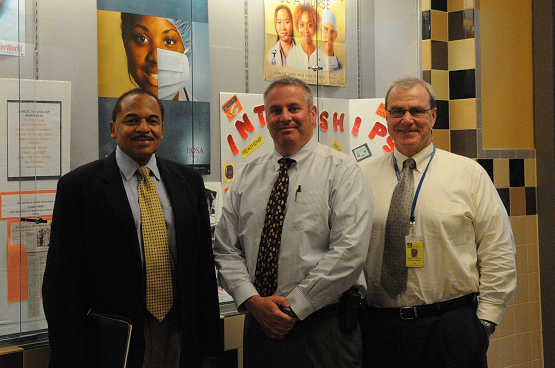
From left, Robert E. Layne, Matthew C. Morse, Terence R. Flotte, MD, and Deborah Harmon Hines, PhD, (not pictured) recently toured the newly opened North High, where the offices of the Worcester Pipeline Collaborative are now located.
Science is alive at the new, $72.8-million North High School in Worcester, where students enjoy access to state-of-the-art laboratories, cutting-edge technology and the offices of the Worcester Pipeline Collaborative.
“We have a facility now with the bricks and mortar to match our programs and meet the educational goals for students when it comes to instruction,’’ said Principal Matthew C. Morse, who recently gave a tour of the newly opened school to Terence R. Flotte, MD, the Celia and Isaac Haidak Professor in Medicine, executive deputy chancellor and provost, and dean of the School of Medicine, and Deborah Harmon Hines, PhD, vice provost for school services and professor of cell biology.
Joined by Robert E. Layne, director of Outreach Programs and the Worcester Pipeline Collaborative, Drs. Flotte and Hines were interested in seeing the new tools available to students interested in health careers. North High is also home to the city’s Health Science Academy.
“It’s great to get out here and see where it all happens,” Dean Flotte said.
The Pipeline, a partnership between UMass Medical School and numerous education, community and business affiliates, gives North High students tutoring, mentoring, internships, laboratory experiences, after -school science clubs and summer research opportunities. The program, one of more than a dozen Pipeline initiatives, is designed to improve students' academic skills in science and mathematics, and increase awareness of careers in health care and biomedical research.
Principal Morse said the differences between the old high school—scheduled for demolition this fall—and the new building are impressive. While the previous building housed just three science labs, the new building has 10. Also, the new labs are built into regular classrooms, to provide a “seamless transition” between lectures and hands-on laboratory bench space, Morse said.
The school also features a sunshine-filled library with a wall of windows, a gymnasium that can hold all 1,150 students and a sophisticated auditorium.
“They’re getting rigor and they’re seeing relevance,’’ Morse said. “The students are seeing the connection between an active sector of the economy (health care) and the class work that they’re conducting. They see the application of how their lessons translate and it’s not always technical—it’s also academic. They see the importance of writing, of the ability to communicate and much more.”
Share this story